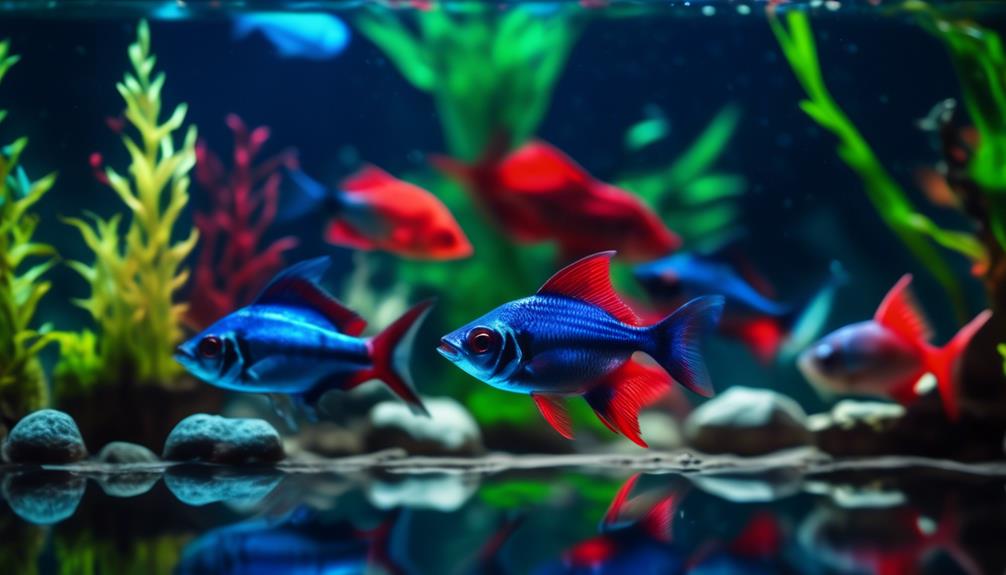Welcome to the world of Cardinal Tetras, where beauty meets tranquility in your very own aquarium. These stunning freshwater fish, known for their vibrant red and iridescent blue stripes, have captured the hearts of aquarists worldwide.
But caring for these little gems requires more than just admiration. In this comprehensive guide, we will explore the intricacies of Cardinal Tetra care, from understanding their origins and distinct characteristics to setting up the perfect habitat and ensuring their optimal nutrition.
But that's not all – we'll also delve into the fascinating world of Cardinal Tetra breeding, unveiling the secrets to successfully raising these captivating creatures.
So, if you're ready to embark on a journey of discovery and create a stunning aquatic oasis, join us as we unlock the ultimate care guide for Cardinal Tetras.
Key Takeaways
- Cardinal tetras are known for their stunning appearance, with a prominent cardinal red stripe paired with an iridescent blue stripe.
- They come from the northern rivers of South America and can live longer and grow bigger in home aquariums.
- Cardinal tetras are the biggest of the tetra species, growing up to 1.75 inches long in captivity.
- Setting up an aquarium for cardinal tetras requires providing them with slow-moving waterways, live plants, and hiding places.
Cardinal Tetras: Appearance and Origin
Cardinal tetras, known for their stunning appearance and originating from the northern rivers of South America, captivate aquarium enthusiasts with their prominent cardinal red stripe paired with an iridescent blue stripe. These vibrant colors make them a popular choice for aquarists looking to add a splash of color to their tanks.
In addition to their striking appearance, cardinal tetras also exhibit interesting behavior and social dynamics. They are a shoaling species, meaning they thrive in groups and feel more secure when surrounded by their own kind. Keeping cardinal tetras in a school of at least 8-10 individuals is recommended to ensure their well-being and reduce stress.
As for health and disease management, cardinal tetras are generally hardy fish when provided with proper care and tank conditions. However, like any fish, they are susceptible to certain diseases such as ich and fin rot. Regular water parameter monitoring, maintaining good water quality, and quarantining new fish before introducing them to the main tank are essential practices to prevent diseases and promote the well-being of cardinal tetras.
Comparison With Other Tetra Species
When comparing cardinal tetras to other tetra species, it is important to consider their distinct characteristics and differences in appearance, size, and coloration. Here are some key points to note:
- Cardinal Tetras vs. Neon Tetras:
- Cardinal tetras are larger, growing up to 1.75 inches (4 cm) long, while neon tetras reach about 1.25 inches (3 cm).
- Cardinal tetras have a full red stripe from the eye to the tail, whereas neon tetras have a half red stripe starting in the middle of their body.
- Both species have a blue horizontal stripe with a red stripe underneath it.
- Keeping cardinal tetras and neon tetras together in the same aquarium is possible but may require careful monitoring due to potential aggression.
- Cardinal Tetras vs. Green Neon Tetras:
- Green neon tetras are the smallest, measuring only 1 inch (2.5 cm) long.
- Green neon tetras have an iridescent turquoise stripe with faint traces of red.
- Differences in behavior between cardinal tetras and green neon tetras are minimal, as they exhibit similar shy and schooling tendencies.
It's essential to consider the pros and cons of keeping cardinal tetras and neon tetras together in the same aquarium, as well as the subtle differences in behavior between cardinal tetras and green neon tetras.
Setting Up the Ideal Aquarium

To create the ideal environment for cardinal tetras, careful consideration must be given to the setup of their aquarium. Start by choosing appropriate aquarium decor that mimics their natural habitat. Cardinal tetras are from slow-moving waterways heavily shaded by rainforests, so provide plenty of live aquarium plants, leaf litter, and driftwood for them to hide, hunt, and breed under.
A tank size of 15-20 gallons or larger is recommended for a minimum of 8-10 cardinal tetras. When selecting tank mates, choose similar-sized community species such as pencilfish, hatchetfish, corydoras catfish, and kuhli loaches. This will ensure peaceful coexistence.
Cardinal Tetra's Nutritional Needs
The nutritional needs of cardinal tetras should be carefully considered to ensure their overall health and well-being in an aquarium environment that mimics their natural habitat. Here are four important points to consider for the cardinal tetra's feeding habits and recommended diet:
- Balanced diet: Cardinal tetras are not picky eaters and readily consume small fish foods like crushed flakes and nano pellets. However, it is important to provide them with a balanced diet that includes a variety of foods to ensure they receive different nutrients and vitamins for a healthy life.
- Supplementary foods: Their diet can be supplemented with freeze-dried tubifex worms, daphnia, frozen cyclops, and live baby brine shrimp. These foods add variety and help meet their nutritional needs.
- Live baby brine shrimp: Feeding them live baby brine shrimp not only adds variety to their diet but also increases their survival rate. It is a highly beneficial food source for their growth and overall health.
- Feeding frequency: Cardinal tetras should be fed small amounts multiple times a day. This helps mimic their natural feeding behavior and ensures they receive adequate nutrition throughout the day.
Breeding Cardinal Tetras

What are the key factors to consider when breeding Cardinal Tetras in a home aquarium? Breeding Cardinal Tetras can be a rewarding experience for aquarium enthusiasts. To ensure successful breeding, it is important to set up a breeding tank that mimics the conditions of their natural habitat. The tank should have an acidic pH below 6.0, low general hardness (GH), and a higher temperature in the low 80s°F (27–29°C). Providing hiding places and spawning material, such as Catappa leaves, java fern, and plastic craft mesh, is crucial for protecting the fertilized eggs from adult tetras. Conditioning the adults with high protein foods, such as live baby brine shrimp and tubifex worms, can increase the chances of successful breeding. By creating the ideal breeding tank setup and protecting the fertilized eggs, you can contribute to the conservation of this beautiful species.
| Factors to Consider | ||
|---|---|---|
| Breeding tank setup | Protecting fertilized eggs | Conditioning the adults |
| – Acidic pH below 6.0 | – Provide hiding places | – High protein foods |
| – Low GH | – Spawning material (e.g., Catappa leaves, java fern) | – Live baby brine shrimp and tubifex worms |
| – Higher temperature (low 80s°F) | – Plastic craft mesh for egg protection | – Increase chances of successful breeding |
Frequently Asked Questions
How Long Do Cardinal Tetras Live on Average?
The average lifespan of cardinal tetras is around 3-5 years. Several factors can affect their lifespan, including water quality, diet, tank conditions, and overall care provided by the owner.
Can Cardinal Tetras Be Kept in a Community Tank With Aggressive Fish?
Cardinal tetras can be kept in a community tank with peaceful fish species. However, due to their shy nature, it is advisable to avoid aggressive tank mates. Consider peaceful alternatives such as pencilfish, hatchetfish, corydoras catfish, and kuhli loaches.
Do Cardinal Tetras Require a Specific Type of Substrate in Their Aquarium?
Cardinal tetras do not require a specific type of substrate in their aquarium. However, a soft and fine-grained substrate, such as sand or small gravel, is recommended to mimic their natural habitat and provide a comfortable environment for them. The substrate also helps in maintaining water quality and serves as a base for live plants.
What Is the Ideal Water Flow Rate for Cardinal Tetras?
Cardinal tetras prefer a gentle water flow rate in their tank setup. A slow to moderate flow mimics their natural habitat of slow-moving waterways. This can be achieved by using a low-powered filter or adjusting the flow rate of a stronger filter.
Are Cardinal Tetras Prone to Any Specific Diseases or Health Issues?
Cardinal tetras are generally hardy and resilient, but they can be susceptible to common aquarium diseases such as ich, fin rot, and fungal infections. Proper water parameters, regular maintenance, and a balanced diet can help prevent health issues.
Conclusion
In conclusion, the care and breeding of Cardinal Tetras require careful attention to their specific needs.
With their vibrant appearance and origin in the rivers of South America, these captivating fish can thrive in a well-maintained aquarium.
By understanding the distinctions between Cardinal Tetras and other Tetra species, enthusiasts can make informed decisions.
Providing the ideal aquarium setup and meeting their nutritional needs ensures their health and longevity.
With proper care and breeding techniques, these stunning Cardinal Tetras will continue to captivate aquarium enthusiasts worldwide.

